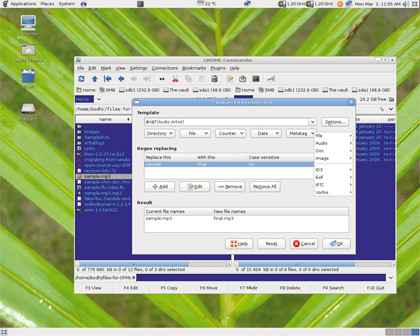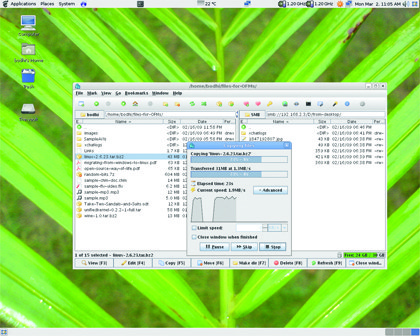6 best orthodox file managers for Linux
Go back to basics with these old-school file managers
Gnome Commander - Mild mannered OFM with an aptitude for renaming files
The only thing Gnome about Gnome Commander (GCMD) is that it's based on the GnomeVFS virtual filesystem. Even that has been deprecated since Gnome 2.22, but that doesn't make GCMD any less commanding. In fact the latest release squeezes even more juice from GnomeVFS and makes GCMD a pleasure to work with over a network.

GNOME COMMANDER: The bulk rename utility is a very handy feature for managing your files
Thanks to the GnomeVFS virtual filesystem, GCMD can connect to Samba and NFS shares, and transfer files over FTP and SSH. Also helpful are the quick access device buttons. GCMD seems to be big on using metadata attached with files. It has a comprehensive bulk file rename utility that can use the metadata attached with the file.
For example you can use the date/time info from a JPEG's Exif data or album/artist info from the MP3's metadata to rename the files with these details. The advanced rename utility also supports regular expressions and gives a preview of the filenames as they'll appear once the batch rename operation is complete. It's really impressive and offers a great amount of flexibility and control.
GCMD currently ships with two plugins – File Roller and CVS. Since GCMD can't handle compressed archives, the File Roller plugin plugs that hole, allowing it to create and extract Zip, Tar, 7z, bz2, Rar, RPM, Deb, and other archive types. But GCMD relies on the graphical Meld tool to help users see the difference and merge files between two files.
If you've got Meld on your box, GCMD will let you compare two files and synchronise directories. However, the command line lacks autocompletion and the gaps in the documentation aren't helpful.
Sign up for breaking news, reviews, opinion, top tech deals, and more.
Version: 1.2.7
Website: www.nongnu.org/gcmd
Price: Free under GPL
Verdict: Powerful metatag rename utility, but lacks documentation and plugins.
Rating: 7/10
MuCommander - The Wile E Coyote of OFMs on Linux
First things first: MuCommander is based on Java and will run on nothing but Sun's own Java runtime environment. If you're using GIJ (the GNU Interpreter for Java), you're out of luck. For the rest of us, MuCommander offers some wonderful features. With it you can browse, compress and uncompress archives in various formats including Zip, Rar, Tar, Gzip, BZ2, ISO/ NRG etc.

MUCOMMANDER: You can compress and uncompress to various file types with this file manager
It also enables you to modify the contents of a Zip archive. MuCommander has several useful switches, and when launching it from the command line you can specify what you want to load in its panes. For example, mucommander smb://192.168.2.2 /Download will display the contents of a Samba share in the first pane, and list /Download in the other. Remember though that you'll have to stare at the splash screen longer than usual as MuCommander tries to connect to the remote machine.
MuCommander supports virtual filesystems and can view files on Samba, NFS shares and on FTP. You can use it to compare files across the two panes. MuCommander has a bulk rename tool and will let you email files without using a third-party app.
This is great, but it didn't work with Gmail's SMTP settings. MuCommander can't encrypt/decrypt files, its built-in command line lacks autocompletion, there's no mount manager and it lacks documentation, which is especially harsh given that the only way to customise the keyboard mapping and alter the buttons on the toolbars is to edit the three XML files – action_keymap.xml, command_ bar.xml, and toolbar.xml.
Version: 0.8.3
Website: www.mucommander.com
Price: Free under GPL
Verdict: Consistent across platforms, but lacks documentation and customisation involves editing XML. Rating: 6/10
Current page: Gnome Commander and MuCommander
Prev Page Krusader and EmelFM2 Next Page Midnight Commander and Beesoft Commander
With almost two decades of writing and reporting on Linux, Mayank Sharma would like everyone to think he’s TechRadar Pro’s expert on the topic. Of course, he’s just as interested in other computing topics, particularly cybersecurity, cloud, containers, and coding.